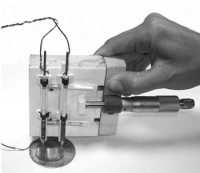Dr John Bond’s method of identifying fingerprints on brass bullet-casings, even after they have been wiped clean, was based on detecting small amounts of corrosion caused by sweat.
Now, working with scientists in the university’s department of chemistry, Bond has developed a simple, handheld device that can measure corrosion on machine parts.
’This is a new, quick, cheap and easy way of measuring the extent of corrosion on copper and copper-based alloys, such as brass,’ said Bond, who is an honorary research fellow in the university’s forensic research centre and scientific support manager at Northamptonshire Police.
Having a corrosion measurement means for copper and alloys such as brass that is quick, portable and cheap enables metals to be tested in situ with no prior set up of a corrosion measuring device.
The technique enables the type of corrosion to be determined - for example, whether it is copper oxide or zinc oxide corrosion. Which one it is gives clues as to how severe the corrosion is.

’This can be done already with X-ray photoelectron spectroscopy [XPS] but that is lab based and very expensive to use. Our technique works off a 9V battery. In that sense, it won’t tell you any more than XPS can, it is just quicker, cheaper and easier,’ said Bond.
A description of the prototype device has been published in the journal Review of Scientific Instruments. Bond and his colleagues are now looking for a company to commercialise the invention.

April 1886: the Brunkebergs tunnel
First ever example of a ground source heat pump?